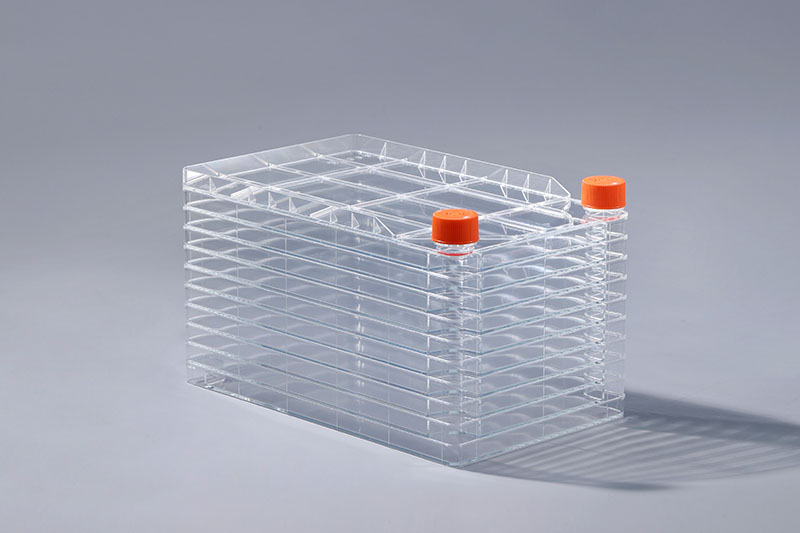बड़े पैमाने पर सेल कल्चर तकनीक से तात्पर्य पर्यावरणीय परिस्थितियों को कृत्रिम रूप से नियंत्रित करने और उच्च घनत्व वाले बड़े पैमाने पर उपयोगी सूक्ष्मजीवों, जानवरों और पौधों की कोशिकाओं की खेती करने की तकनीक से है। यह जीन पुनर्संयोजन, कोशिका संलयन और खाद्य और दवा जैसे औद्योगिक उत्पादन में अन्य प्रौद्योगिकियों द्वारा प्राप्त बड़ी संख्या में नई कोशिकाओं का आधार है। उद्योग में, टीकों, मोनोक्लोनल एंटीबॉडी या दवा उद्योग के बड़े पैमाने पर उत्पादन में सेल कारखानों का व्यापक रूप से उपयोग किया जाता है। सामान्य पशु कोशिकाएं जिन्हें बड़े पैमाने पर संवर्धित किया गया है, उनमें चिकन भ्रूण फाइब्रोब्लास्ट, प्राथमिक हम्सटर किडनी कोशिकाएं और अन्य प्राथमिक कोशिकाएं, साथ ही मानव द्विगुणित कोशिकाएं, CHO कोशिकाएं और वेरो कोशिकाएं शामिल हैं। इन कोशिकाओं का व्यापक रूप से वैक्सीन उत्पादन, मोनोक्लोनल एंटीबॉडी तैयारी, एरिथ्रोपोइटिन और अन्य उत्पाद क्षेत्रों में उपयोग किया जाता है। यह एक कुशल सेल संस्कृति उपभोज्य है और कई वैज्ञानिक अनुसंधान संस्थानों और दवा कंपनियों द्वारा इसका समर्थन किया जाता है। आमतौर पर बड़े पैमाने पर सेल कल्चर में उपभोग्य सामग्रियों का उपयोग किया जाता है। अनुयाई कोशिकाओं की संस्कृति के लिए उपयुक्त। अपने प्रशिक्षण पैमाने का विस्तार करने के लिए, इसे परतों की संख्या में वृद्धि करके प्राप्त किया जा सकता है। यह प्रशिक्षण पद्धति बड़े स्थान के उपयोग को अधिकतम कर सकती है, पौधों के स्थान को बचा सकती है, और जनशक्ति और भौतिक संसाधनों को बचा सकती है।
The common layers of cell factories include 1 layer, 2 layers, 5 layers, 10 layers, 40 layers, etc., which are mainly suitable for the culture of adherent cells. To expand its training scale, it can be achieved by increasing the number of layers. This training method can maximize the utilization of large space, save plant space, and save manpower and material resources.
In industry, cell factories are widely used in mass production of vaccines, monoclonal antibodies or the pharmaceutical industry. Common animal cells that have been cultured on a large scale include chicken embryo fibroblasts, primary hamster kidney cells and other primary cells, as well as human diploid cells, CHO cells, and Vero cells. These cells are widely used in vaccine production, monoclonal antibody preparation, erythropoietin and other product fields.
In addition, large-scale cell culture through cell factories can reduce the number of cell culture devices and reduce the risk of cell contamination. It is an efficient cell culture consumable and is favored by many scientific research institutions and pharmaceutical companies.
The FAI climbed 5.9 percent year-on-year in the first 11 months of 2018, quickening from the 5.7-percent growth in Jan-Oct, the National Bureau of Statistics (NBS) said Friday in an online statement.
The key indicator of investment, dubbed a major growth driver, hit the bottom in August and has since started to rebound steadily.
In the face of emerging economic challenges home and abroad, China has stepped up efforts to stabilize investment, in particular rolling out measures to motivate private investors and channel funds into infrastructure.
Friday's data showed private investment, accounting for more than 60 percent of the total FAI, expanded by a brisk 8.7 percent.
NBS spokesperson Mao Shengyong said funds into weak economic links registered rapid increases as investment in environmental protection and agriculture jumped 42 percent and 12.5 percent respectively, much faster than the average.
In breakdown, investment in high-tech and equipment manufacturing remained vigorous with 16.1-percent and 11.6-percent increases respectively in the first 11 months. Infrastructure investment gained 3.7 percent, staying flat. Investment in property development rose 9.7 percent, also unchanged.
 English
English



















































